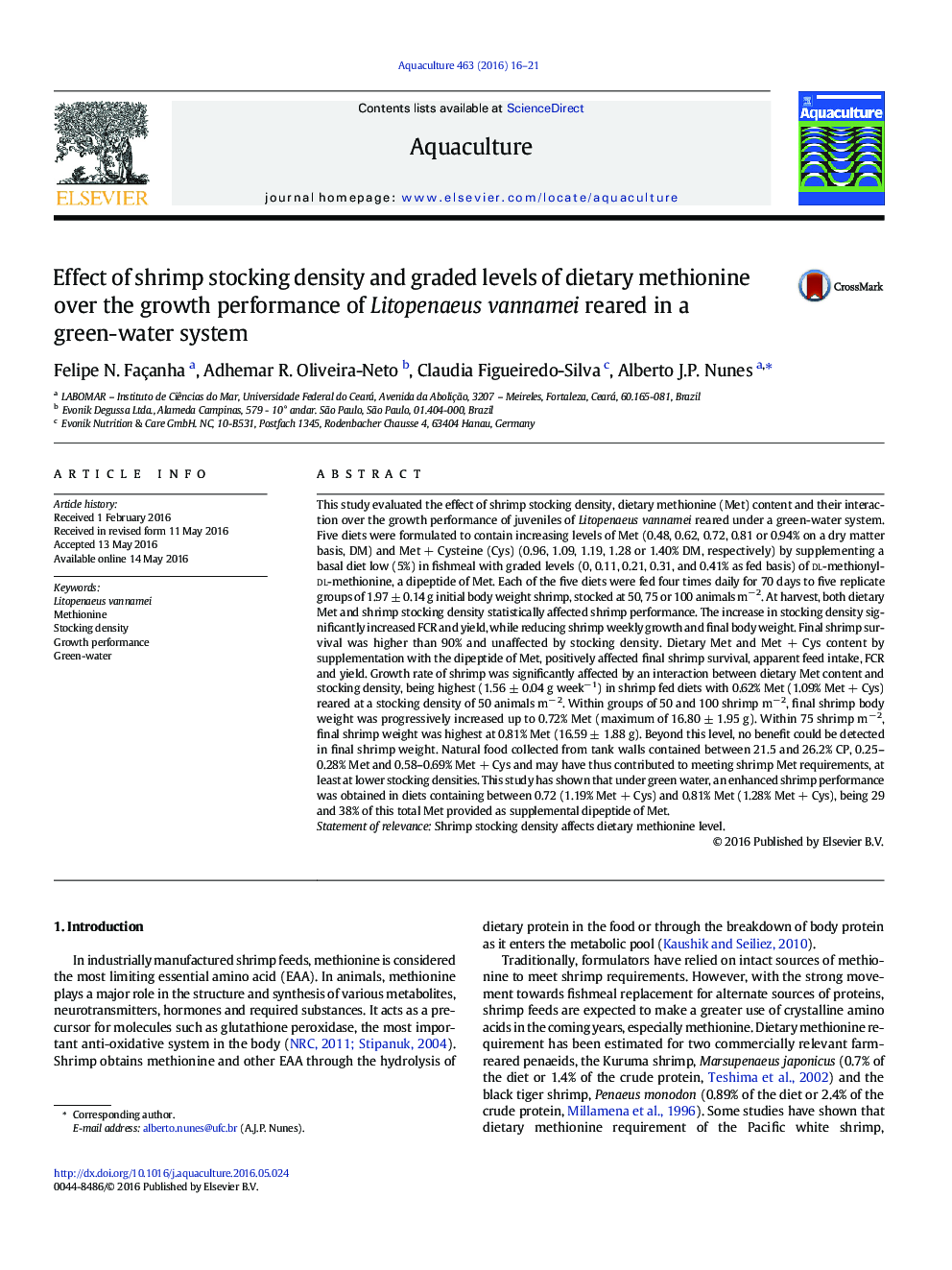| کد مقاله | کد نشریه | سال انتشار | مقاله انگلیسی | نسخه تمام متن |
|---|---|---|---|---|
| 2421333 | 1552824 | 2016 | 6 صفحه PDF | دانلود رایگان |

• Dietary Met should account for the level of shrimp stocking density when shrimp is reared in a green-water environment.
• From 50 to 75 shrimp m-2, dietary Met content should vary between 0.72 (1.19% Met + Cys) and 0.81% Met (1.28% Met + Cys).
• Higher or lower levels may be required and dependent on natural food.
This study evaluated the effect of shrimp stocking density, dietary methionine (Met) content and their interaction over the growth performance of juveniles of Litopenaeus vannamei reared under a green-water system. Five diets were formulated to contain increasing levels of Met (0.48, 0.62, 0.72, 0.81 or 0.94% on a dry matter basis, DM) and Met + Cysteine (Cys) (0.96, 1.09, 1.19, 1.28 or 1.40% DM, respectively) by supplementing a basal diet low (5%) in fishmeal with graded levels (0, 0.11, 0.21, 0.31, and 0.41% as fed basis) of dl-methionyl-dl-methionine, a dipeptide of Met. Each of the five diets were fed four times daily for 70 days to five replicate groups of 1.97 ± 0.14 g initial body weight shrimp, stocked at 50, 75 or 100 animals m− 2. At harvest, both dietary Met and shrimp stocking density statistically affected shrimp performance. The increase in stocking density significantly increased FCR and yield, while reducing shrimp weekly growth and final body weight. Final shrimp survival was higher than 90% and unaffected by stocking density. Dietary Met and Met + Cys content by supplementation with the dipeptide of Met, positively affected final shrimp survival, apparent feed intake, FCR and yield. Growth rate of shrimp was significantly affected by an interaction between dietary Met content and stocking density, being highest (1.56 ± 0.04 g week− 1) in shrimp fed diets with 0.62% Met (1.09% Met + Cys) reared at a stocking density of 50 animals m− 2. Within groups of 50 and 100 shrimp m− 2, final shrimp body weight was progressively increased up to 0.72% Met (maximum of 16.80 ± 1.95 g). Within 75 shrimp m− 2, final shrimp weight was highest at 0.81% Met (16.59 ± 1.88 g). Beyond this level, no benefit could be detected in final shrimp weight. Natural food collected from tank walls contained between 21.5 and 26.2% CP, 0.25–0.28% Met and 0.58–0.69% Met + Cys and may have thus contributed to meeting shrimp Met requirements, at least at lower stocking densities. This study has shown that under green water, an enhanced shrimp performance was obtained in diets containing between 0.72 (1.19% Met + Cys) and 0.81% Met (1.28% Met + Cys), being 29 and 38% of this total Met provided as supplemental dipeptide of Met.Statement of relevanceShrimp stocking density affects dietary methionine level.
Journal: Aquaculture - Volume 463, 1 October 2016, Pages 16–21